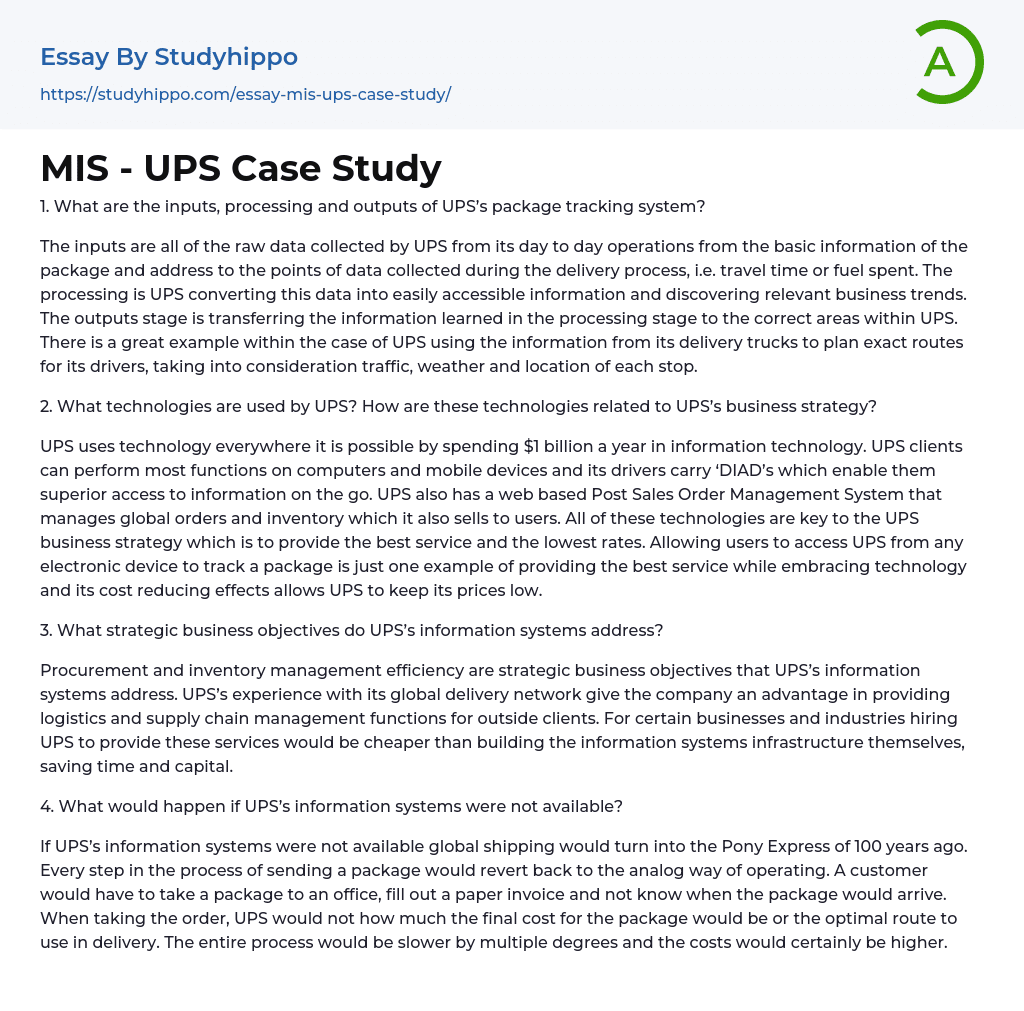1. What are the inputs, processing and outputs of UPS’s package tracking system?
The inputs are all of the raw data collected by UPS from its day to day operations from the basic information of the package and address to the points of data collected during the delivery process, i.e. travel time or fuel spent. The processing is UPS converting this data into easily accessible information and discovering relevant business trends. The outputs stage is transferring the information learned in the processing stage to the correct areas within UPS. There is a great example within the case of UPS using the information from its delivery trucks to plan exact routes for its drivers, taking into consideration traffic, weather and location of each stop.
2. What technologies are used by UPS? How are the
...se technologies related to UPS’s business strategy?
UPS uses technology everywhere it is possible by spending $1 billion a year in information technology. UPS clients can perform most functions on computers and mobile devices and its drivers carry ‘DIAD’s which enable them superior access to information on the go. UPS also has a web based Post Sales Order Management System that manages global orders and inventory which it also sells to users. All of these technologies are key to the UPS business strategy which is to provide the best service and the lowest rates. Allowing users to access UPS from any electronic device to track a package is just one example of providing the best service while embracing technology and its cost reducing effects allows UPS to keep its prices low.
3. What strategic business objectives d
UPS’s information systems address?
Procurement and inventory management efficiency are strategic business objectives that UPS’s information systems address. UPS’s experience with its global delivery network give the company an advantage in providing logistics and supply chain management functions for outside clients. For certain businesses and industries hiring UPS to provide these services would be cheaper than building the information systems infrastructure themselves, saving time and capital.
4. What would happen if UPS’s information systems were not available?
If UPS’s information systems were not available global shipping would turn into the Pony Express of 100 years ago. Every step in the process of sending a package would revert back to the analog way of operating. A customer would have to take a package to an office, fill out a paper invoice and not know when the package would arrive. When taking the order, UPS would not how much the final cost for the package would be or the optimal route to use in delivery. The entire process would be slower by multiple degrees and the costs would certainly be higher.
- Chief Executive Officer essays
- Convenience Store essays
- Firm essays
- Training And Development essays
- Unilever essays
- Variable Cost essays
- Virgin Group essays
- Bargaining essays
- Entity essays
- Pest analysis essays
- John Locke essays
- 9/11 essays
- A Good Teacher essays
- A Healthy Diet essays
- A Modest Proposal essays
- A&P essays
- Academic Achievement essays
- Achievement essays
- Achieving goals essays
- Admission essays
- Advantages And Disadvantages Of Internet essays
- Alcoholic drinks essays
- Ammonia essays
- Analytical essays
- Ancient Olympic Games essays
- APA essays
- Arabian Peninsula essays
- Argument essays
- Argumentative essays
- Art essays
- Atlantic Ocean essays
- Auto-ethnography essays
- Autobiography essays
- Ballad essays
- Batman essays
- Binge Eating essays
- Black Power Movement essays
- Blogger essays
- Body Mass Index essays
- Book I Want a Wife essays
- Boycott essays
- Breastfeeding essays
- Bulimia Nervosa essays
- Business essays
- Business Process essays
- Canterbury essays
- Carbonate essays
- Catalina de Erauso essays
- Cause and Effect essays
- Cesar Chavez essays




